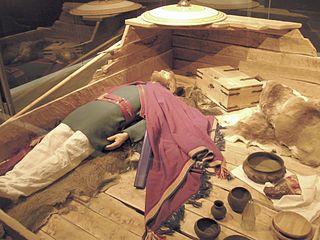
The Baiuvarii, Bavarii, or Bavarians were a Germanic people. The Baiuvarii had settled in modern-day Bavaria, Austria, and South Tyrol by the 6th century AD, and are considered to be the ancestors of modern-day Bavarians and Austrians. It is believed that they spoke an early version of the Bavarian language.

The Marcomanni were a Germanic people that established a powerful kingdom north of the Danube, somewhere near modern Bohemia, during the peak of power of the nearby Roman Empire. According to Tacitus and Strabo, they were Suebian.
Maroboduus was a king of the Marcomanni, who were a Germanic Suebian people. He spent part of his youth in Rome, and returning, found his people under pressure from invasions by the Roman empire between the Rhine and Elbe. He led them into the forests of Bohemia, near to the Quadi who already lived nearby, and established a large alliance.

The Suebi were a large group of Germanic peoples originally from the Elbe river region in what is now Germany and the Czech Republic. In the early Roman era they included many peoples with their own names such as the Marcomanni, Quadi, Hermunduri, Semnones, and Lombards. New groupings formed later, such as the Alamanni and Bavarians, and two kingdoms in the Migration Period were simply referred to as Suebian.

The 1st century was the century spanning AD 1 (I) through AD 100 (C) according to the Julian calendar. It is often written as the 1st century AD or 1st century CE to distinguish it from the 1st century BC which preceded it. The 1st century is considered part of the Classical era, epoch, or historical period. The 1st century also saw the appearance of Christianity.

The 10s decade ran from January 1, AD 10, to December 31, AD 19.
The 0s BC were the period between 9 BC and 1 BC, the last nine years of the before Christ era. It is one of two "0-to-9" decade-like timespans that contain nine years, along with the 0s.
Year 8 BC was either a common year starting on Friday or Saturday or a leap year starting on Thursday of the Julian calendar and a common year starting on Wednesday of the Proleptic Julian calendar. At the time, it was known as the Year of the Consulship of Censorinus and Gaius Asinius. The denomination 8 BC for this year has been used since the early medieval period, when the Anno Domini calendar era became the prevalent method in Europe for naming years.

The Quadi were a Germanic people who lived approximately in the area of modern Moravia in the time of the Roman Empire. The only surviving contemporary reports about the Germanic tribe are those of the Romans, whose empire had its border on the River Danube just to the south of the Quadi. They associated the Quadi with their neighbours the Marcomanni, and described both groups as having entered the region after the Celtic Boii had left it deserted. The Quadi may later have contributed to the "Suebian" group who crossed the Rhine with the Vandals and Alans in the 406 Crossing of the Rhine, and later founded a kingdom in northwestern Iberia.

The Lugii were a large tribal confederation mentioned by Roman authors living in ca. 100 BC–300 AD in Central Europe, north of the Sudetes mountains in the basin of upper Oder and Vistula rivers, covering most of modern southern and middle Poland.
The Indo-Parthian Kingdom was a Parthian kingdom founded by Gondophares, and active from 19 CE to c. 226 CE. At their zenith, they ruled an area covering parts of eastern Iran, various parts of Afghanistan and the northwest regions of the Indian subcontinent. The rulers may have been members of the House of Suren, and the kingdom has even been called the "Suren Kingdom" by some authors.
The Gutones were a Germanic people who were reported by Roman era writers in the 1st and 2nd centuries to have lived in what is now Poland. The most accurate description of their location, by the geographer Ptolemy, placed them east of the Vistula river.

Tiberius Julius Aspurgus Philoromaios was a prince and Roman client king of the Bosporan Kingdom.

Roman portraiture was one of the most significant periods in the development of portrait art. Originating from ancient Rome, it continued for almost five centuries. Roman portraiture is characterised by unusual realism and the desire to convey images of nature in the high quality style often seen in ancient Roman art. Some busts even seem to show clinical signs. Several images and statues made in marble and bronze have survived in small numbers. Roman funerary art includes many portraits such as married couple funerary reliefs, which were most often made for wealthy freedmen rather than the patrician elite.
Inguiomer or Ingomar was a leader of the Cherusci. He is chiefly remembered as the uncle of Arminius.
Catualda was a Marcomannic exile who deposed the Marcomannic king Maroboduus in 18 AD.

Vibilius or Vibillius was a powerful king of the Hermunduri in the 1st century AD, mentioned in The Annals of the Roman historian Tacitus. According to Tacitus, Vibilius deposed the Marcomannic king Catualda, who had himself deposed Maroboduus in 18 AD. Catualda was subsequently succeeded by the Quadian client king Vannius. In 50 AD however, along with Vannius' nephews Vangio and Sido and allied Lugii, Vibilius also in turn led the deposition of Vannius.
Segimer or Sigimer was a chieftain of the Germanic Cherusci tribe. He is chiefly remembered as the father of Arminius, who led the Germans to victory over the Romans at Teutoburg Forest in AD 9.







